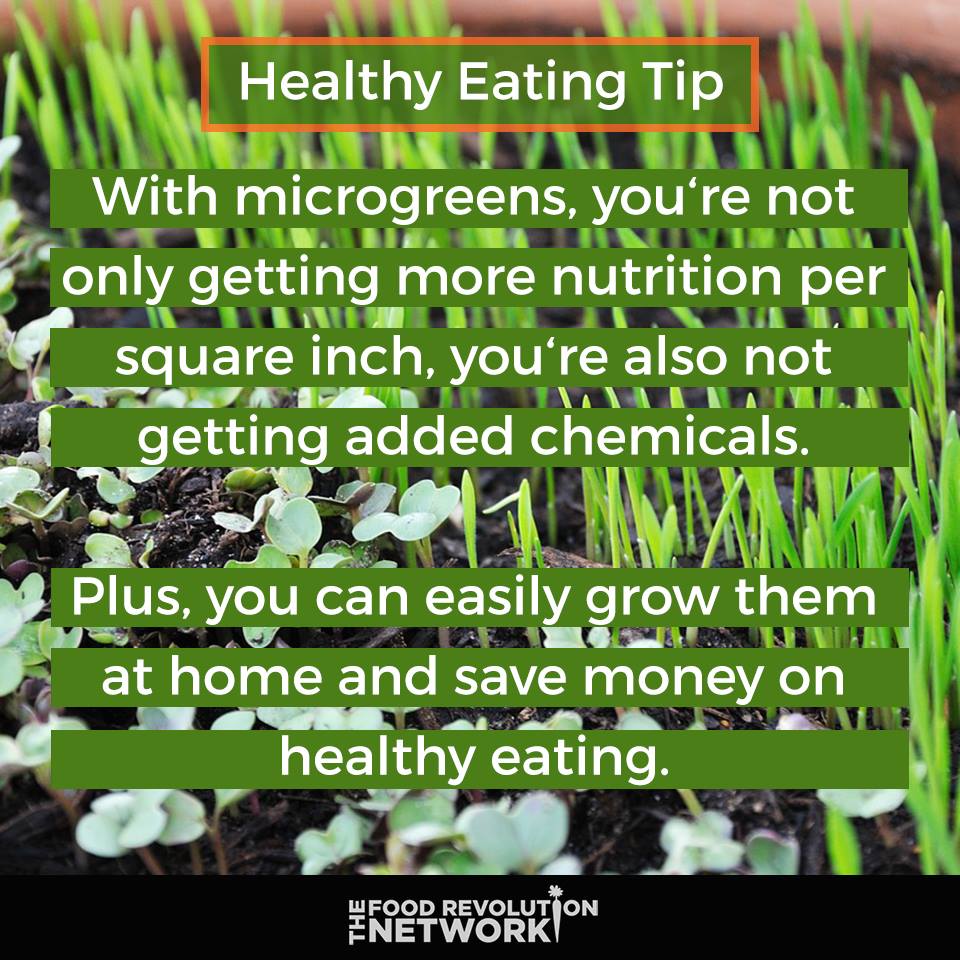By Dr. Deanna Minich • Originally published on DeannaMinich.com
If you’ve ventured into the depths of the fruit & vegetable aisle in the supermarket, you may be familiar with small packages containing brightly colored, tiny leaves known as microgreens.
These tender immature greens produced from the seeds of vegetables, herbs, and flowers are usually harvested within 7 – 14 days after germination and are about 1 – 3 inches in height. But don’t be fooled by their miniature appearance: microgreens are more than pretty garnishes—they pack intense flavors and impressive nutritional profiles into their small package.
We know fruits and vegetables are great sources of vitamins and minerals as well as antioxidants, and as such, they possess protective effects against diseases such as cancer, cardiovascular disease, cataracts, and diabetes while also decreasing the recurrence of pathological events.
Microgreens may have more nutrients than fully grown leaves
When we discuss the wholesome effects of vegetables, we often think of “full-sized” vegetables like broccoli, cauliflower, cabbage, Brussels sprouts, kale, spinach, mustard greens, collard greens, carrots, celery, and so on as main sources of health-promoting nutrients. Yet, in the past few years, research has elucidated the superior profile of antioxidant vitamins and minerals present in microgreens.
In a study by Xiao et al., researchers sought to determine the concentrations of ascorbic acid (vitamin C), carotenoids (vitamin A), phylloquinone (vitamin K1), and tocopherols (vitamin E) in 25 commercially available microgreens. The results demonstrated that certain microgreens possessed higher nutritional densities than the fully grown leaves.
For instance, the higher concentration of vitamin K1 was found in garnet amaranth followed by red sorrel, green basil, pea tendrils, and red cabbage microgreens. The amounts were superior to that of their mature vegetables. Red cabbage and garnet amaranth microgreens had the highest concentrations of vitamin C followed by China rose radish, opal basil, and opal radish.
The concentration of vitamin C in red cabbage microgreens was 2.4 times greater than the estimated average requirement (EAR), while China rose radish, opal basil, and opal radish microgreens had approximately 1.5 times the Recommended Dietary Allowance (RDA) of vitamin C, even more so than broccoli.
Red sorrel had the highest β-carotene (provitamin A) concentration followed by cilantro, red cabbage, and peppercress. Wasabi, green basil, pea tendrils, and garnet amaranth microgreens are also abundantly concentrated with β-carotene, even comparable to sources like carrots and sweet potatoes. Green daikon radish was found to have extremely high α- and γ-tocopherol (vitamin E) content. Finally, cilantro, opal radish, and peppercress microgreens were also shown to be excellent sources of α- and γ-tocopherol, even higher than mature spinach leaves.
Microgreens are great for the environment
Another interesting aspect of cultivating microgreens is the potentially gentler impact on the environment compared to fully grown plants. Currently, in the US, food production uses 50% of land and accounts for 80% of total freshwater consumption.5 In addition, agricultural soil management is a big contributor to N2O emissions and pesticide use, with the US exceeding 1.1 billion pounds in 2006 and 2007, accounting for 22% of total world pesticide amountused and 25% of world herbicide amount used!
A study published in the Journal Frontiers in Nutrition made a systematic comparison of the environmental impact of microgreens (specifically broccoli microgreens) cultivation methods as well as their nutritional profile compared to mature broccoli.
Based on the findings, it was estimated that broccoli microgreens would require 158 – 236 times less water than nutritionally equivalent mature vegetables and take 93 – 95% less harvesting time without the need for fertilizer, pesticides, or energy-demanding transport from farm to table. Additionally, regardless of the growing method, microgreens had larger quantities of magnesium, manganese, copper, and zinc than mature broccoli, with compost-grown microgreens having even higher phosphorus, potassium, magnesium, manganese, zinc, iron, calcium, sodium, and copper levels.
Another point favoring microgreens is the fact that they require virtually no pesticide use due to their rapid harvest time, so you’re not only getting more nutrition per square inch, you’re also not getting any added chemicals.
Also, since microgreens can easily be grown at home, those who opt to grow their own can also significantly lower their supermarket costs. You can easily find the GMO-free, organic seeds available for sale on websites like Johnny Seeds, Eden Brothers, Growing Microgreens, or Sprout People.
Here’s how to grow your own microgreens:
- Get the GMO-free, organic seeds.
- For quicker germination, pre-soak larger seeds in warm water for a few hours or overnight.
- If you are using a tray, lay some moistened paper towel or cloth on the bottom, and fill the container about 3/4 full of moist growing medium 1 inch deep.
- Scatter your seeds over the soil and press in lightly.
- Water lightly by misting with a spray bottle.
- Place on a drainage tray or saucer in a warm spot ideally near a window with sunlight or in a designated area in your garden.
- Mist the seeds every day as needed (check soil moisture by touching with your fingers).
- To create a warm, humid environment for the seeds to germinate, cover the seeds with a lid or add a clear plastic bag over the top of the tray, without touching the plants, with holes snipped in the top for airflow.
- Microgreens are usually ready to harvest in a couple of weeks. When the seedlings are 1 – 3 inches tall, depending on the variety, your microgreens are ready.
- Using scissors, cut stems just above the soil when ready to enjoy.
If growing is not for you, you can find ready to eat microgreens at your local supermarket or farmer’s market. With so many benefits, the old proverb “good things come in small packages” could easily be microgreens’ tagline.





